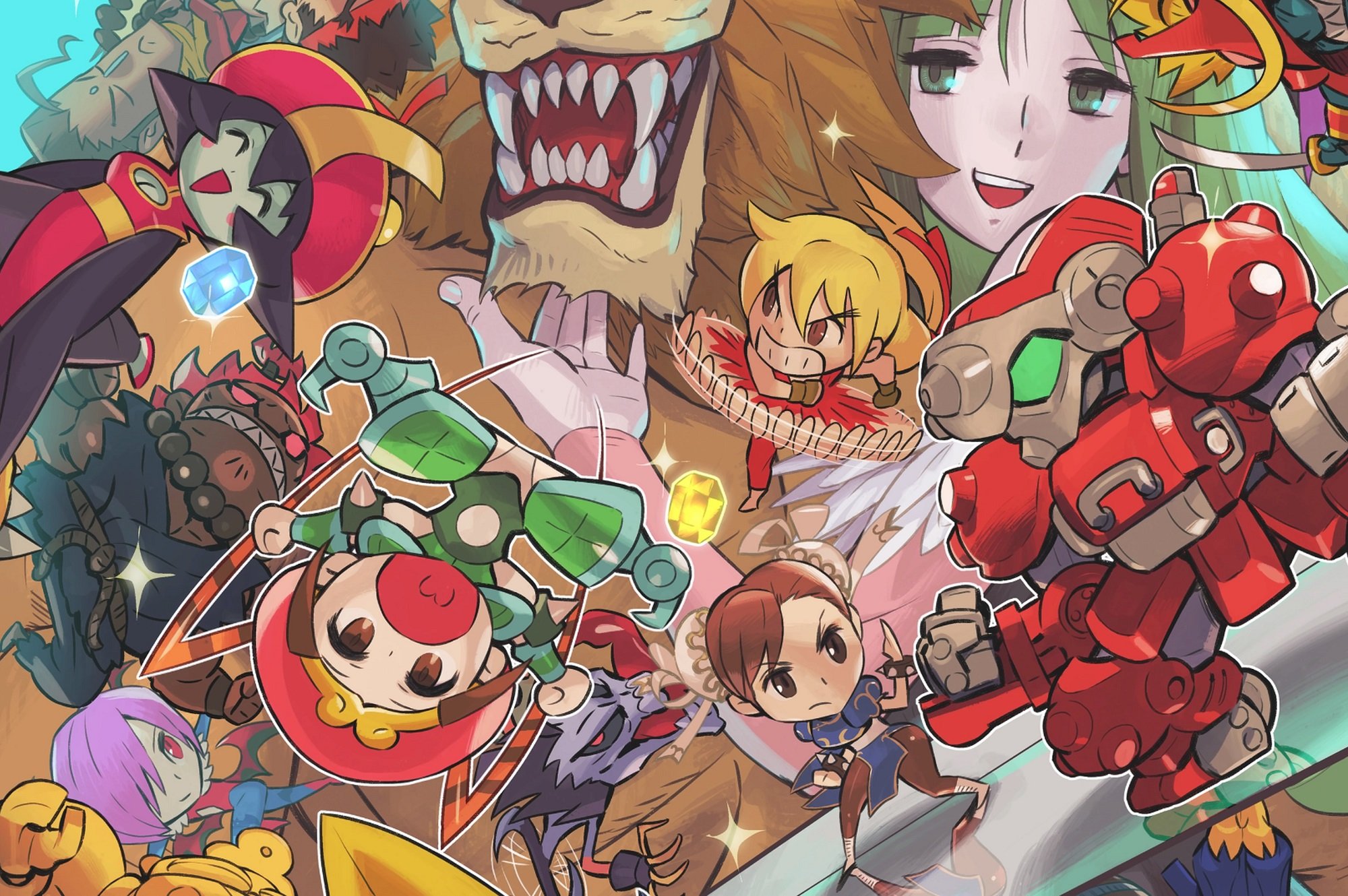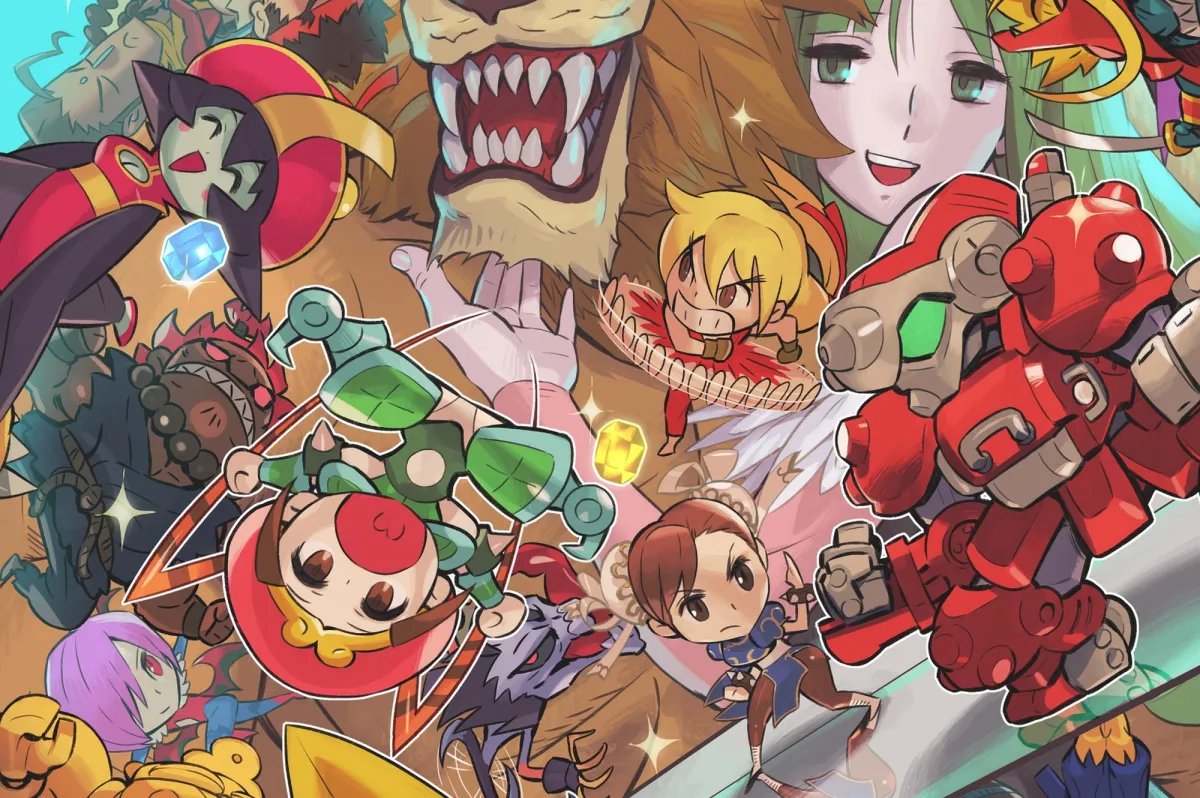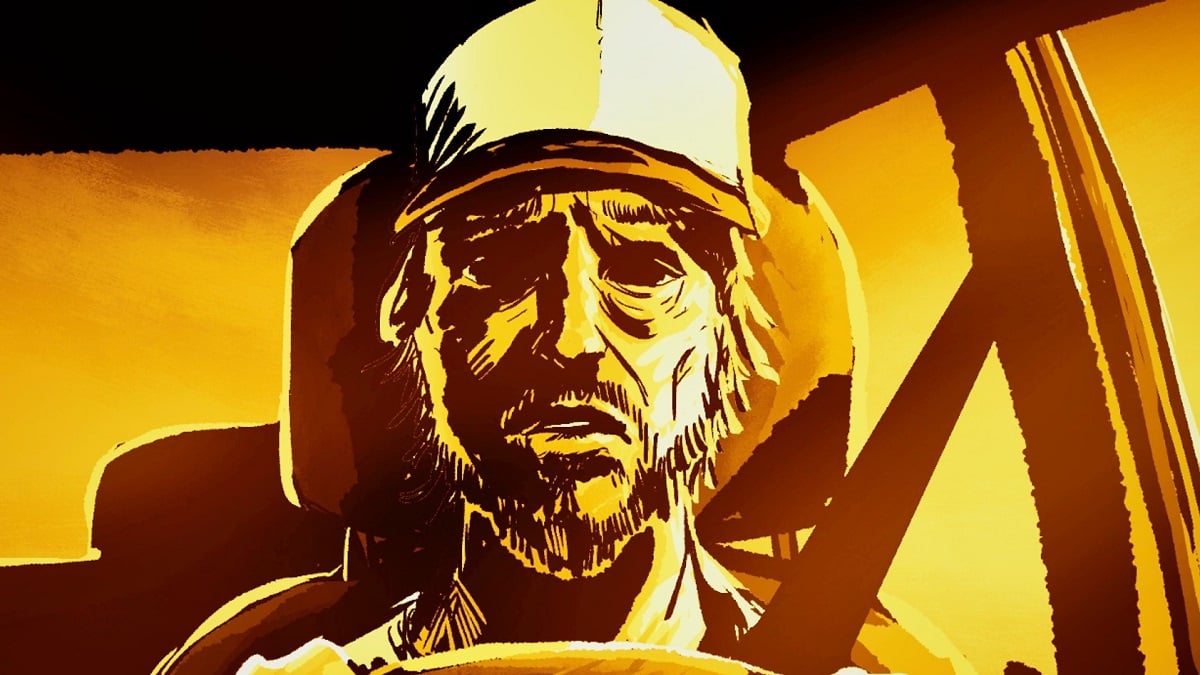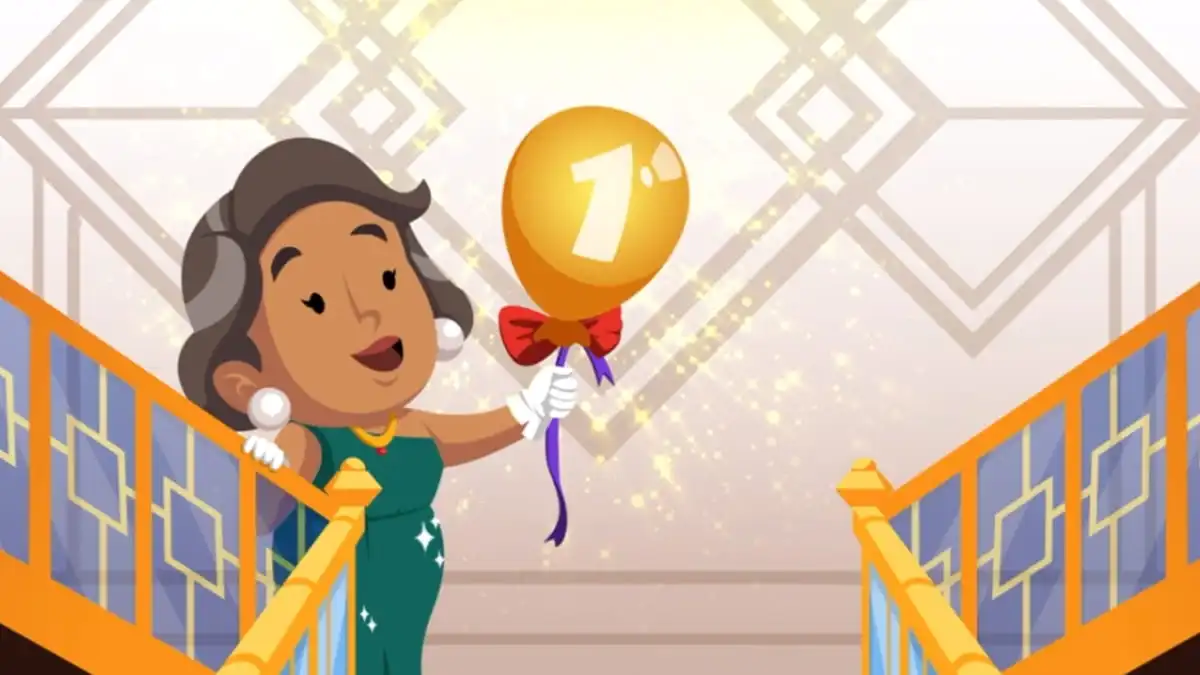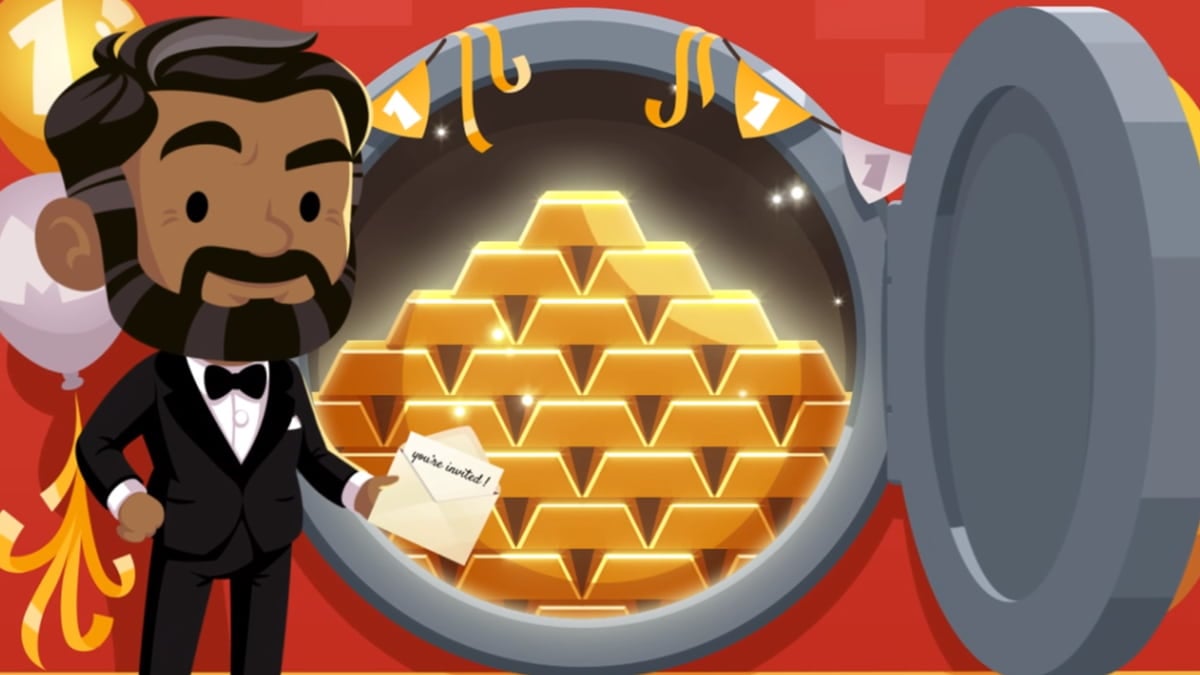I live among the creatures of the fight
It’s been over a decade since former Capcom producer Yoshinori Ono asked a room of San Diego Comic-Con attendees to literally wave money in the air to “prove” how much they wanted a brand new title in M.I.A. series Darkstalkers. And how many sequels has the Gothic fight franchise seen since that fateful show of dedication? Try zero. The stunt didn’t take with the suits, and Darkstalkers remains in a shallow grave on the grounds of Capcom HQ.
One thing that Capcom has been showing passion for, however, is retro compilations, having released three such titles in as many years. Today, we’re looking at Capcom Fighting Collection, which compiles a fistful of coin-op hits, most of which were not featured in the Street Fighter 30th Anniversary Collection, the Capcom Beat ‘Em Up Bundle, Capcom Arcade Stadium, or the incoming, Capcom Arcade 2nd Stadium. Did I miss any?
Given the number of CapComComps already available, one would think there was little reason to publish another. But this particular collection does include the Darkstalkers series. In fact, over half of the games featured here star Morrigan and her groovy ghoulies. While Capcom isn’t quite prepared to resurrect the series for the modern fighting game market, it is savvy enough to recognize the brand’s continued sales potential among its starving fanbase… Morrigan ain’t the only bloodsucker.

Capcom Fighting Collection (PS4 [reviewed], PC, Xbox One, Nintendo Switch)
Developer: Capcom
Publisher: Capcom
Released: June 24, 2022
MSRP: $39.99
The Capcom Fighting Collection consists of 10 coin-op releases that dropped during Capcom’s golden ’90s age. I’m hesitant to use the term “classics” as, frankly, so few of these releases saw wide circulation, especially when stood against quarter-guzzling releases in the Mortal Kombat, King of Fighters, Tekken, and Capcom’s own Street Fighter franchise. In fact, many of these titles saw more popularity in their home releases, finding bigger audiences on the Sony PlayStation and Sega Saturn. People love to bang on about how “obsessed” they were with Darkstalkers but, from experience, it simply wasn’t killing it on-site, with most western fighting game players queuing up for X-Men vs. Street Fighter or Tekken 2.
Obviously, that doesn’t mean that Darkstalkers/Vampire/Night Warriors isn’t deserving of a place in fighting game history — it’s a really great, electric franchise, packed out with cool monster characters, Gothic aesthetics, and, of course, one of Capcom’s most recognizable sirens, Morrigan Aensland. Here in CFC, players can enjoy the first two entries Darkstalkers: The Night Warriors (1994), and Night Warriors: Darkstalkers’ Revenge (1995), as well as Vampire Savior, Vampire Hunter 2, and Vampire Savior 2 (1997) — revamps of each other that, essentially, form Darkstalkers 3.
It should be noted that while the first two titles in the series are showing their age in the modern climate, Vampire Savior 2 still kicks all kinds of ass, with a wicked roster of over-the-top characters, gorgeous pixel art animation, and stages that range from the sublime to the vomit-inducing. (Lordy, that space baby). By the time Vampire Savior rose from its grave, Capcom had already begun its love affair with Marvel, and this is reflected in Vampire Savior‘s magnificently theatrical gameplay, bolstered by its sinister charisma and chaotic charm. It’s a grim gem, delightful even to the holiest of eyes.
Speaking of gems, the Capcom Fighting Collection features two further titles that are perhaps best remembered for their home ports rather than their arcade appearances. Super Puzzle Fighter II Turbo (1996) mixes in Capcom’s famous fighters with a block-busting puzzler, with chibi versions of characters such as Sakura, Ryu, Chun-Li, Morrigan, and Felicia fighting it out in tile-dropping madness. It’s a typical “match colors” affair, with precise chains causing your chibi avatar to lay down super moves on your opponent, looking for the ultimate K.O. Like so many tile-based puzzlers, SPFIIT has aged well, and is still a lot of frantic fun when played against savvy opponents.
Sticking with the gem theme, Super Gem Fighter Mini Mix (1997) is perhaps the silliest and cutest title in Capcom’s storied history. A one-on-one fighter with a difference, SGFMM (also known as Pocket Fighter) has a who’s who of chibi Capcom warriors punch it out in unique, gem-based battles. While on the surface a “Mighty Street Fighter,” SGFMM is a little more complex, with the player gathering (or stealing) gemstones mid-fight to unlock flashy specials, combos, and supers.
The most memorable feature is the “Costume Combo” mechanic, which sees the fighter change into a range of humourous outfits to attack the opponent. Felicia rocks a Mega Man cosplay, Morrigan is a sexy nurse/waitress, Akuma becomes an Olympic swimmer, and Chun-Li gets her Jill Valentine on. Honestly, the game was ridiculous then and it is now, but it’s still a good time, and once you get the mechanics down, you can have a lot of fun with this fanservice-heavy release.

Once we get past the Darkstalkers and “Gem Fighter” titles, Capcom Fighting Collection gets a little more obscure. Receiving its first-ever home release, Red Earth (1996) is an exceptionally unique fighter that attempts to blend fantasy RPGs with 2D fighting games to birth a new genre. While two players can engage in typical one-on-one combat, sporting a roster of frankly bizarre and even nightmarish characters, the single-player mode actually sees the player embark upon a lore-filled fantasy quest, set in the far-off future of 1999.
Red Earth is a meticulous and very deliberate fighting title, rewarding precision and match-up knowledge over button-mashing. It would make waves within the industry for its distinct dual-gameplay and “save game” feature. It is also surprisingly violent by Capcom standards, featuring all manner of blood and gore and rewarding the player with different endings depending on their blood lust. It’s been a long time coming, and its unique concepts make for an eye-opening experience. Thanks for coming.
Much like Red Earth, Cyberbots: Full Metal Madness (1994) is another ambitious release that saw Capcom aiming to redefine the very genre it had popularized. This mech fighter allows players to choose a pilot and one of many distinct mechs, before squaring off in heavy metal warfare. Cyberbots introduced mechanics such as weapon cooldown, reloading, and the damaging of appendages, attempting to capture the epic encounters of animes such as Gundam or Robotech. Oh, and one of the pilots is a crying naked woman in a bubble. Of course.
Both Red Earth and Cyberbots were, from a sales standpoint, a little too ambitious for their own good. While both games have intriguing characters, cool design, and unique mechanics, today they serve as records of experimentation — novel attempts to carry fighters into new territories from both an aesthetic and a gameplay standpoint. It’s wonderful to have them archived here in this collection, as they are marvelous curiosities worth playing in their own right. As interesting today as they were 25 years ago.
The package is rounded out with Hyper Street Fighter II: Anniversary Edition… I don’t need to write about this again. For full clarity, it is the recently censored version as featured on SF30.

In regards to the package itself, Capcom Fighting Collection is passable, offering a little more meat than the Capcom Arcade Stadium, but not even close to the museum aesthetics of Street Fighter 30th Anniversary Collection. Most of the included titles are tweaked ROM dumps, though a unique Training Mode has been developed for each game. In regards to extras, the tree is a little bare, with merely a few sheets of concept art or marketing materials for each title, and that’s it. Both the English and Japanese ROMs are selectable for all games. Frustratingly, the custom controls menu is a little unkind to fight sticks, and I found I needed a pretty clunky setup to offer buttons for Coin, Start, and the pause menu.
All 10 titles feature online multiplayer via rollback netcode, which essentially means that the Darkstalkers community now has an (official) online version of the series that it can play for life. A useful feature allows players to pick and choose the games they want to play, and CFC will match you up with anybody looking for a match in any of your selected titles. I managed to play most of the included titles online during launch week, and can report successful, strong connections. Unfortunately, the available matches tapered off a little as the week progressed, but the players are out there.
This is why crossplay (which is not supported in CFC) is a vital part of solidifying communities.

Capcom Fighting Collection features 10 solid fighters, with no real dud among them. Still, one can’t help but feel a nagging pang of needlessness, given the existence of Capcom Arcade Stadium and the publisher’s other compilations. I’m not sure why all of these titles could not have simply been offered as a paid DLC drop for that release, or for Capcom Arcade 2nd Stadium, especially when one considers the lack of extras offered in this package. I’m sure the dedicated Darkstalkers fans will be very happy to have the series readily available on their hard drives. And ultimately, that is the selling point here, whether you waved a dollar in the air at SDCC or not.
Oh, but if I see a “Capcom Shoot-‘Em-Up Collection” in 2023… then you’re just taking the piss.
Capcom Fighting Collection is a no-frills compilation of the pugilistic publisher’s secondary catalog, offering well-aged revisits to Darkstalkers, the gem fighter spin-offs, and some ambitious and intriguing experiments. Outside of its important job as an archival piece, it’s a somewhat barebones collection, hurt by lack of crossplay, and questionable existence given Capcom’s established range of compilations. Regardless, it remains a must-buy for all long-suffering Night Warriors.
[This review is based on a retail build of the game provided by the publisher.]
